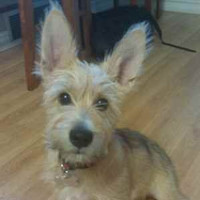Appearance of the Schnorgi
|
| The exact appearance of these small designer dogs can be difficult to determine, as there are a number of possible combinations. Some dogs will adopt more of the traits of the Corgi parent, while other puppies will more closely resemble the Schnauzer. A common Schnorgi combination is to have the body of a Corgi and the head of a Schnauzer. This means their body is generally long and their little legs are short and stubby. Their ears can vary, some being large and floppy, others erect. The Schnorgi's basic color is yellow, black, tan or white, with whiskers on the chin and ears that can be black or gray. The texture of the Schnorgi's coat will be rough like that of the Schnauzer parent. Other features of this hybrid breed, such as eyes, muzzle, legs and tail, can be developed from either parent, giving all dogs a unique look. |
Temperament of the Schnorgi
|
| The Schnorgi is a very gentle hybrid that also makes an excellent pet as it gets on well with children, although it prefers older children. They are very playful and intelligent dogs that should be easy to train. These dogs don't usually bark, except when they're playing. They are very affectionate dogs who love to cuddle and spend time with their owners, and therefore make wonderful pets. All in all, they're great dogs, although some say they can be stubborn. For dogs who are known to be stubborn, it's important to make your authority clear and let them know that you're the master, not them. Start teaching your dog respect and basic obedience at an early age, using positive reinforcement. It's also essential to socialize your pet from an early age. By familiarizing him with different environments, people and animals, you ensure that he will be calm and comfortable in all scenarios as an adult. |
Needs and activities of the Schnorgi
|
| The Schnorgi adopts the high energy levels of the Schnauzer and Corgi. Like the Schnauzer, it will get as much exercise as possible. At the very least, these dogs need a brisk walk or even a daily jog. It's also important to give them time to play and run freely in a safe, enclosed space. Don't overexert puppies, however, as they are still growing and could be injured more easily. These dogs can also be active indoors, like the parent Corgi. They should exercise for about an hour a day. The strict minimum is 20 minutes a day, but chances are they'll need more than that. You also need to keep your dog mentally occupied, especially if it's a highly intelligent dog, with fun and stimulating games. |
Maintenance of the Schnorgi
|
| These dogs should be low-maintenance, as they don't shed much. However, if your Schnorgi puppy's coat displays certain characteristics specific to Schnauzers, it may need trimming from time to time. Schnauzers need daily brushing, due to their dense undercoat. It should also be fully trimmed about twice a year. The fur around the eyes and ears also needs trimming from time to time. The Corgi has a simpler grooming routine. It should be combed, brushed and bathed only when necessary. Schnorgis should also have their teeth brushed daily if possible, or at least two or three times a week. This will keep teeth strong and gums healthy, preventing bad breath and cavities. Nails should be trimmed once or twice a month, depending on how active the dog is and how quickly the nails wear out on their own. Ears should be cleaned once a week to prevent ear infections. |









 English (United Kingdom)
English (United Kingdom)